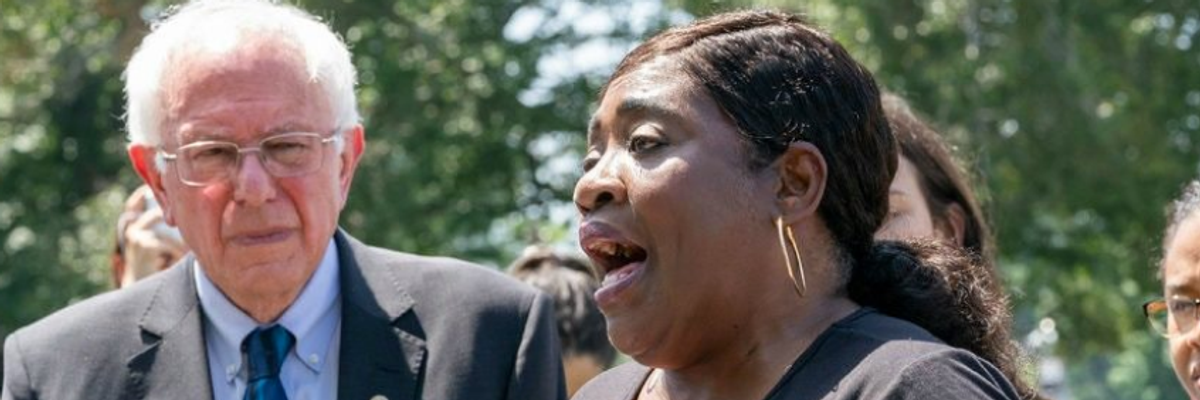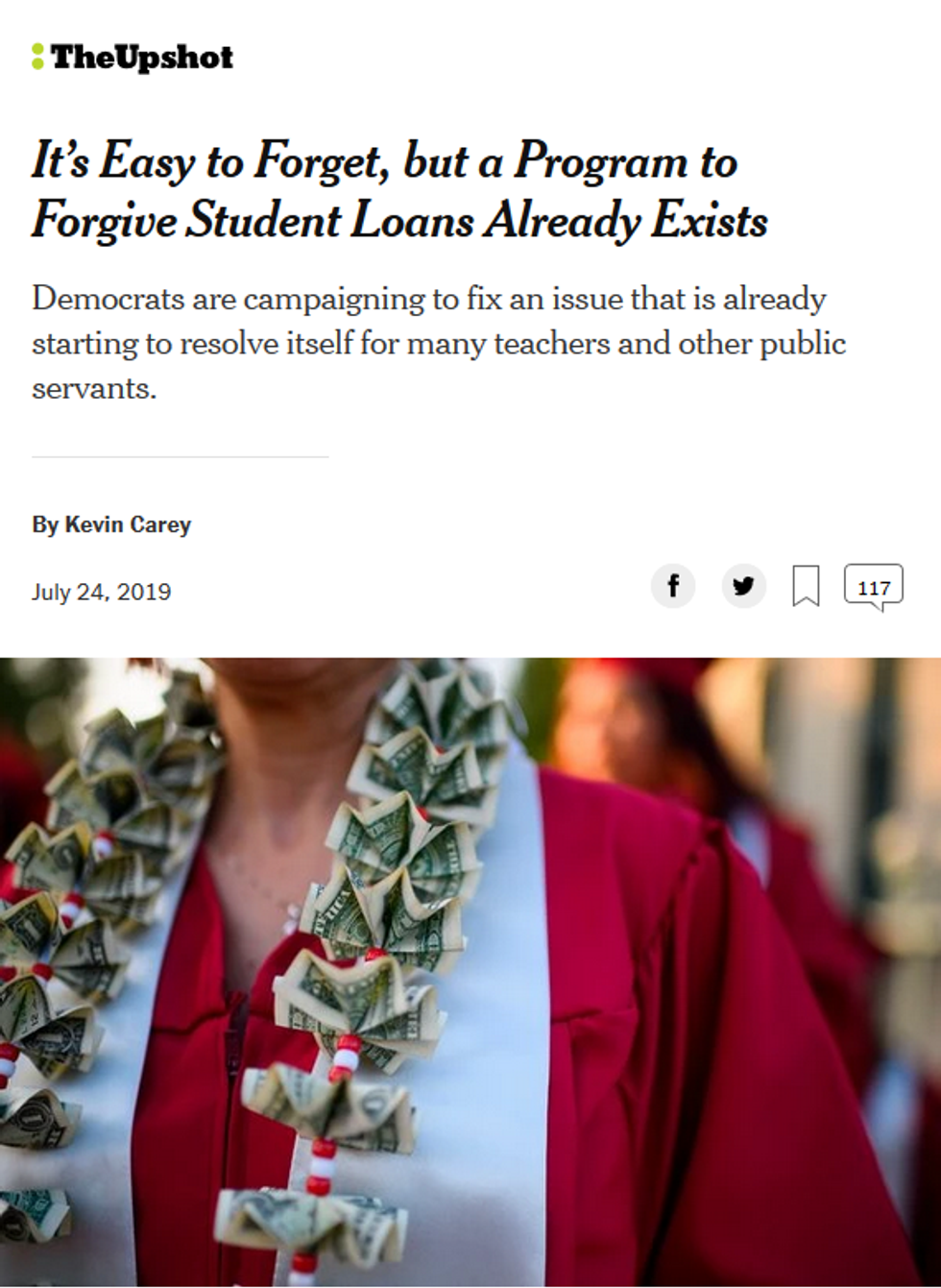

SUBSCRIBE TO OUR FREE NEWSLETTER
Daily news & progressive opinion—funded by the people, not the corporations—delivered straight to your inbox.
5
#000000
#FFFFFF
To donate by check, phone, or other method, see our More Ways to Give page.


Daily news & progressive opinion—funded by the people, not the corporations—delivered straight to your inbox.

New York Times depiction (7/24/19) of Bernie Sanders at a student debt rally with indebted former student Pamela Hunt. (Photo: J. Scott Applewhite/AP)
Why are Democratic candidates going on about student loan debt? Why, the problem is practically solved already!
That's the message of a piece in The Upshot (7/24/19)--the New York Times' project aimed at "examining politics, policy and everyday life in new ways"--written by Kevin Carey, who directs education policy at the New America foundation. (New America's higher education program is largely funded by Bill and Melinda Gates.)

"It's Easy to Forget, but a Program to Forgive Student Loans Already Exists," is the headline. The subhead clarifies: "Democrats are campaigning to fix an issue that is already starting to resolve itself for many teachers and other public servants."
After outlining proposals by Bernie Sanders and Elizabeth Warren for large-scale forgiveness of student loans, Carey writes:
What's strange about the new crop of proposals is that the Department of Education already has a public service loan forgiveness program, called PSLF, which President George W. Bush signed into law in 2007.
Sure, Carey admits, almost no one who applies for this program has their debts forgiven:
In the 18 months after borrowers with a decade of service in government or nonprofit jobs first became eligible in 2017, 73,554 people applied to have their student loans wiped out. And 73,036 were turned down--a rejection rate of 99.3 percent.
But that's a problem that's going to work itself out over time, Carey explains at great length--applicants will figure out over time how to make themselves eligible for this extremely convoluted program. The bottom line, writes Carey:
Nearly half of the $870 billion in outstanding Direct Loans -- the kind that are eligible for loan forgiveness -- is being repaid through income-driven plans, the kind that are eligible for loan forgiveness. And one in four American workers is in a job eligible for the forgiveness program.
So nearly half of $870 billion in debt is eligible for loan forgiveness, and one in four workers have jobs that qualify them for that program. If you do the math, that's very roughly $100 billion that could theoretically be forgiven--or about 6 percent of the $1.6 trillion in outstanding student debt.
The upshot, according to Carey: What are these candidates belly-aching about?
Democrats competing to help teachers and other public servants with loans may be about to spend hundreds of billions of dollars to fix a problem that is already on the way to being solved.
Or 6 percent of it, anyway.
Dear Common Dreams reader, The U.S. is on a fast track to authoritarianism like nothing I've ever seen. Meanwhile, corporate news outlets are utterly capitulating to Trump, twisting their coverage to avoid drawing his ire while lining up to stuff cash in his pockets. That's why I believe that Common Dreams is doing the best and most consequential reporting that we've ever done. Our small but mighty team is a progressive reporting powerhouse, covering the news every day that the corporate media never will. Our mission has always been simple: To inform. To inspire. And to ignite change for the common good. Now here's the key piece that I want all our readers to understand: None of this would be possible without your financial support. That's not just some fundraising cliche. It's the absolute and literal truth. We don't accept corporate advertising and never will. We don't have a paywall because we don't think people should be blocked from critical news based on their ability to pay. Everything we do is funded by the donations of readers like you. Will you donate now to help power the nonprofit, independent reporting of Common Dreams? Thank you for being a vital member of our community. Together, we can keep independent journalism alive when it’s needed most. - Craig Brown, Co-founder |
Why are Democratic candidates going on about student loan debt? Why, the problem is practically solved already!
That's the message of a piece in The Upshot (7/24/19)--the New York Times' project aimed at "examining politics, policy and everyday life in new ways"--written by Kevin Carey, who directs education policy at the New America foundation. (New America's higher education program is largely funded by Bill and Melinda Gates.)

"It's Easy to Forget, but a Program to Forgive Student Loans Already Exists," is the headline. The subhead clarifies: "Democrats are campaigning to fix an issue that is already starting to resolve itself for many teachers and other public servants."
After outlining proposals by Bernie Sanders and Elizabeth Warren for large-scale forgiveness of student loans, Carey writes:
What's strange about the new crop of proposals is that the Department of Education already has a public service loan forgiveness program, called PSLF, which President George W. Bush signed into law in 2007.
Sure, Carey admits, almost no one who applies for this program has their debts forgiven:
In the 18 months after borrowers with a decade of service in government or nonprofit jobs first became eligible in 2017, 73,554 people applied to have their student loans wiped out. And 73,036 were turned down--a rejection rate of 99.3 percent.
But that's a problem that's going to work itself out over time, Carey explains at great length--applicants will figure out over time how to make themselves eligible for this extremely convoluted program. The bottom line, writes Carey:
Nearly half of the $870 billion in outstanding Direct Loans -- the kind that are eligible for loan forgiveness -- is being repaid through income-driven plans, the kind that are eligible for loan forgiveness. And one in four American workers is in a job eligible for the forgiveness program.
So nearly half of $870 billion in debt is eligible for loan forgiveness, and one in four workers have jobs that qualify them for that program. If you do the math, that's very roughly $100 billion that could theoretically be forgiven--or about 6 percent of the $1.6 trillion in outstanding student debt.
The upshot, according to Carey: What are these candidates belly-aching about?
Democrats competing to help teachers and other public servants with loans may be about to spend hundreds of billions of dollars to fix a problem that is already on the way to being solved.
Or 6 percent of it, anyway.
Why are Democratic candidates going on about student loan debt? Why, the problem is practically solved already!
That's the message of a piece in The Upshot (7/24/19)--the New York Times' project aimed at "examining politics, policy and everyday life in new ways"--written by Kevin Carey, who directs education policy at the New America foundation. (New America's higher education program is largely funded by Bill and Melinda Gates.)

"It's Easy to Forget, but a Program to Forgive Student Loans Already Exists," is the headline. The subhead clarifies: "Democrats are campaigning to fix an issue that is already starting to resolve itself for many teachers and other public servants."
After outlining proposals by Bernie Sanders and Elizabeth Warren for large-scale forgiveness of student loans, Carey writes:
What's strange about the new crop of proposals is that the Department of Education already has a public service loan forgiveness program, called PSLF, which President George W. Bush signed into law in 2007.
Sure, Carey admits, almost no one who applies for this program has their debts forgiven:
In the 18 months after borrowers with a decade of service in government or nonprofit jobs first became eligible in 2017, 73,554 people applied to have their student loans wiped out. And 73,036 were turned down--a rejection rate of 99.3 percent.
But that's a problem that's going to work itself out over time, Carey explains at great length--applicants will figure out over time how to make themselves eligible for this extremely convoluted program. The bottom line, writes Carey:
Nearly half of the $870 billion in outstanding Direct Loans -- the kind that are eligible for loan forgiveness -- is being repaid through income-driven plans, the kind that are eligible for loan forgiveness. And one in four American workers is in a job eligible for the forgiveness program.
So nearly half of $870 billion in debt is eligible for loan forgiveness, and one in four workers have jobs that qualify them for that program. If you do the math, that's very roughly $100 billion that could theoretically be forgiven--or about 6 percent of the $1.6 trillion in outstanding student debt.
The upshot, according to Carey: What are these candidates belly-aching about?
Democrats competing to help teachers and other public servants with loans may be about to spend hundreds of billions of dollars to fix a problem that is already on the way to being solved.
Or 6 percent of it, anyway.